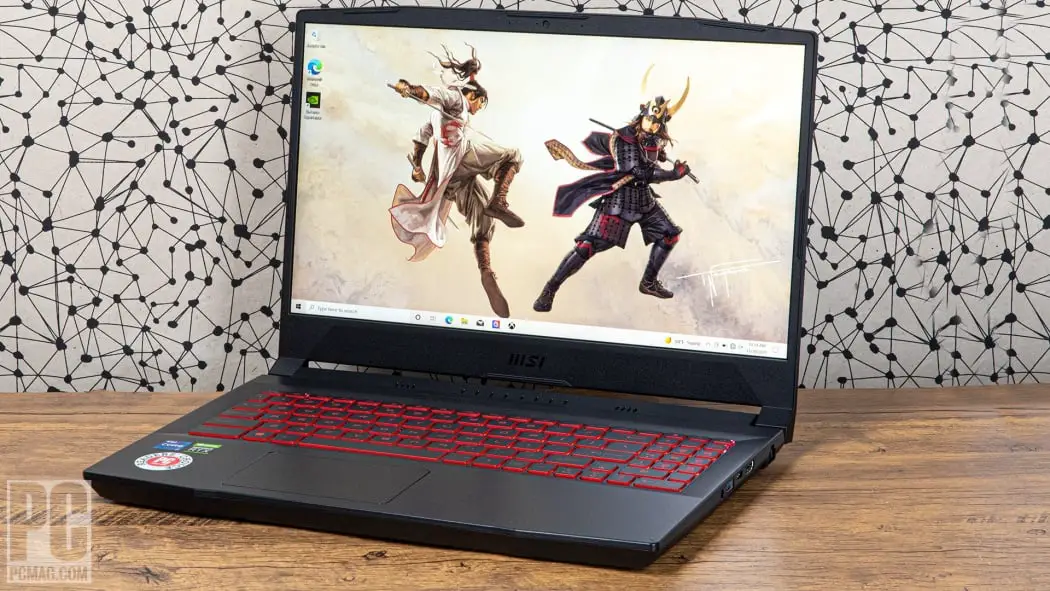MSI has renewed its entry level gamer with a brand new laptop, the Katana GF66. Equipped with an 11th-generation Intel Core i7 processor and a GeForce RTX 3050, it seems ready to do battle.
Our Review
Presentation
With the arrival of Intel’s 11th generation processors for gaming laptops, MSI is renewing its entry-level chassis. The Katana is available in 15.6 inches (GF66) and 17 inches (GF76), embeds an Intel Core i5 or i7 processor. It is especially decked out with the very recent GeForce RTX 3050 from Nvidia. It is the 15.6-inch Intel Core i7 version that is now in our hands.
Construction
MSI seems to have settled down on the design. Although made of plastic, the chassis is particularly sober. The hood features the brand’s crest with a dragon, but simply engraved on it. The plastic has a matte finish with the only drawback that it easily attracts fingerprints and is difficult to remove.
Once the laptop is open, the atmosphere is the same: no RGB on the menu, but a simple keyboard with red backlighting. The typeface used on the gaming keyboard lacks readability and the line of numbers is reversed (numbers in small and special characters in large). MSI has managed to cram a numeric keypad, but it turns out to be particularly cramped.
The touch is however pleasant and responds perfectly. On the other hand, the rigidity under the space bar and at the level of the touchpad leaves much to be desired. Finally, the touchpad is relatively small (10.5 x 6.5 cm), but the glide is pleasant and the clicks do not go too deep.
The Katana GF66’s connectivity is made up of three full-format USB ports, including two USB 3.0 ports, a USB-C port, an RJ45 jack, an HDMI port and, of course, a headphone jack. Everything is complete, although we would have liked the USB-C port to have Thunderbolt.
Wireless connectivity is provided by the Intel AX201 chip which allows the Katana to benefit from wifi 6 (2400 Mb / s) and Bluetooth 5.2. The webcam does not deviate from the standard of the moment and remains in 720p – its rendering therefore leaves much to be desired.
Cooling is provided by two fans on either side of the gaming PC. Good point, three air extractions are present and do not blow on the right hand. MSI did not see fit to allow the user to adjust the ventilation according to its use. The MSI Center is hopelessly empty of any adjustments …
The temperature recorded is particularly high all around the chassis. We measured after 15 min of play ( Assassin’s Creed Odyssey ) nearly 55 ° C to the left of the keyboard. This one is also not spared with nearly 50 ° C in its center. Despite the two fans, the MSI Katana seems to have a hard time dissipating the heat emitted by the Core i7 and the RTX 3050. The noise pollution is also particularly high with 47.2 dB during our game session and nearly 52 dB on the occasion of our encoding in HandBrake which requires only the processor, but much more intensely than a game.
To access the interior of the Katana GF66, it is necessary to remove 10 screws and unclip the hull delicately, starting at an angle, while being particularly careful of the plastics of the vents which are quite thin and can break at the slightest twist.
Inside, the memory, SSD, wifi card and battery are easily replaceable. A 2.5-inch slot is even available to install a SATA storage unit (hard drive or SSD, as desired). When removing the shell, we noticed an amazing thing: MSI weighted it down with a metal plate in order to balance the PC. Indeed, the battery occupies the right two-thirds of the Katana and unbalances the machine. This ballast allows the balance to be rebalanced.
Performances
The MSI Katana GF66 11UC-098FR is equipped with an Intel Core i7-11800H processor supported by 16 GB of DDR4, a 512 GB NVMe SSD and a GeForce RTX 3050. Having already mentioned the performance of the processor in detail, we will content ourselves with summarize the gist of it below.
The Intel Core i7-11800H makes the MSI Katana GF66 one of the best-performing laptops around today, although it lags a little behind the Asus A15 and its AMD Ryzen 7 5800H processor. However, we note the good progress compared to its predecessor, the Core i7-10875H.
Games
With the GeForce RTX 3050 from Nvidia, MSI inaugurates this model in our database. The GeForce RTX 3050 has 4 GB of video memory with a 60 W TGP on our model. However, it does not have the Dynamic Boost 2.0 function which offers a slight performance boost if the processor is not used much, and vice versa.
According to the gaming panel that determines our index, the MSI Katana and its GeForce RTX 3050 get an index of 93, which places the Katana between the Acer Nitro 5 AN515 (79) and its GTX 1650 Ti, and the Asus Dash F15 with RTX GeForce RTX 3060 (124). Note however that even if the performance of the GeForce RTX 3050 is “only” 16% better than the GeForce GTX 1650 Ti, and unlike the latter, the RTX benefits from the entire recent Nvidia ecosystem with raytracing , Reflex, Broadcast and especially DLSS.
We also tested a few recent games while we waited for our new procedure. So by just enabling DLSS, we played Cyberpunk 2077 at 39 fps, The Medium at 55 fps, and Control at 70 fps.
Screen
MSI has decked out the Katana GF66 with a 15.6-inch IPS panel displaying 1920 x 1080 px at 144 Hz. The matte finish helps to contain reflections since we noted a reflectance of 21%. However, the maximum brightness of the panel is relatively low at 264 cd / m².
The contrast of 1127: 1 is average for IPS panels. The temperature is 6633 K, therefore close to the ideal video standard (6550 K). It is mainly by the absence of calibration that the panel sins. Thus, the delta E was measured at 5.8 with notable drifts on green, blue and purple. Despite the use of a reactive panel (144 Hz), the afterglow at 20 ms is a bit high for a portable gamer and could cause drag in fast games.
Audio
Two loudspeakers equip the MSI Katana GF66. They are located under the chassis and deliver a cramped sound with the real feel of it coming out of a box. Everything lacks bass and focuses on the mids. In order to improve the sound a little, we advise you to activate the Nahimic software, but to deactivate all the improvements it performs.
The headphone output does not shine in any of its features. The sound level of 155 mVRMS, while sufficient, will be a bit light to support headphones with high impedance.
Mobility / Autonomy
The MSI Katana GF66 measures 35.9 x 25.9 cm by 2.5 cm thick, which is classic dimensions for a 15.6 inch laptop dedicated to games. The weight is relatively contained with 2.1 kg. The computer can therefore easily be placed in your backpack.
The 56 Wh battery runs out quickly: it took a little over 2 h 30 min to overcome it with our usual protocol (Netflix under Chrome, brightness at 200 cd / m² and headphones plugged in at 50%). We are aware that this is a gaming laptop, but under these conditions it is not even able to take half a day away from an electrical outlet. The 150 W charger allows the PC to be charged in just over an hour.
Conclusion
The MSI Katana GF66 really leaves us hungry for more. Its chassis and first-rate performance are prime assets. But the lack of care given to its cooling system, as well as a poorly calibrated panel got the better of its rating. The configuration also seems unbalanced for a player. An Intel Core i5-11400H processor and the GeForce RTX 3050 Ti would have provided better performance in this area.

